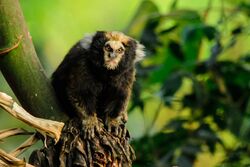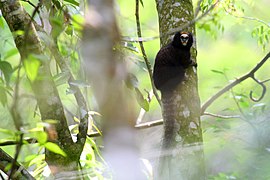Biology:Buffy-tufted marmoset
| Buffy-tufted marmoset[1][2] | |
|---|---|

| |
| Scientific classification | |
| Domain: | Eukaryota |
| Kingdom: | Animalia |
| Phylum: | Chordata |
| Class: | Mammalia |
| Order: | Primates |
| Suborder: | Haplorhini |
| Infraorder: | Simiiformes |
| Family: | Callitrichidae |
| Genus: | Callithrix |
| Species: | C. aurita
|
| Binomial name | |
| Callithrix aurita (É. Geoffroy, 1812)
| |

| |
| Synonyms | |
| |
The buffy-tufted marmoset (Callithrix aurita), also known as the buffy tufted-ear marmoset or white-eared marmoset, is a New World monkey that lives in the forests on the Atlantic coast of southeast Brazil . Of all the marmosets, it has the southernmost range.[5]
The buffy-tufted marmoset resembles the common marmoset, but is somewhat larger. It has grey-black skin, and the most obvious differences from the common marmoset are its whitish face ("skull-like facial mask",[6]) brown crown, and shorter ear tufts.
Distribution
The buffy-tufted marmoset is endemic to the Atlantic Forest of southern Brazil, occurring in ombrophilous and semideciduous forests in the Serras do Mar and Mantiqueira in the states of Minas Gerais, São Paulo, and Rio de Janeiro, and extending to the North of Rio Doce in Minas Gerais.[7] They forage and travel in the lower canopy and dense understorey vegetation, typically found between 6 and 9 meters above the ground. Alongside C. flaviceps, they are the species inhabiting areas with the most extreme climatic conditions.[8]
It occurs in perennial, semideciduous, secondary, mixed montane forests, interspersed with stands of bamboo at altitudes ranging from 80 to 1200 meters.[9][10]
Morphology
It has an overall black coloration, but they can also be found with reddish spots or speckled with red, without presenting a general pattern of stripes. Moreover, its reddish spots provide the characteristic golden hue that gave rise to the species' name "aurita". Its forehead is white, with the sides of the face being black, sometimes speckled with red. They have short (20 to 50 mm), white intra-auricular tufts that can vary to a brownish hue. The feet are brown, and the hands are a strongly weathered brown color. The tail is black with white rings.[11]
It is probably the largest species in the Callithrix genus, weighing 400-450 g and with a body length of 19-25 cm and a tail length of 27-35 cm.[12]
Ecology
It is diurnal and arboreal, living almost all its life in the trees in groups that usually consist of 4 to 8 individuals, although it's possible to find groups of 11 individuals, with only one reproductive pair of male and female, with a dominant female.[8][13] The offspring, always twins, are born after a gestation period of 144 days and are carried by the parents in the first weeks of life. Older siblings assist in caring for the offspring. When they reach adulthood, they migrate to other groups to form new pairs.[14][15] Their activity period is reduced during hot-dry times. During the rainy season - 6:30-19:00 / dry season - 7:30-16:30. Their resting sites are associated with dense vegetation.[8]
They feed on resins and other plant secretions, as well as plant material itself, such as fruits and tree gum. During dry periods, they adapt their diet to include animal matter, such as lepidoptera larvae, orthopterans, cockroaches, spiders, harvestmen, snakes, lizards, small frogs and bird eggs.[16] Studies also show that this species can feed on bamboo fungi.[3]
It can establish sympatry with other species like those of the genus Cebus and Callicebus, but there are no records of sympatry with other forms of Callithrix.[17]
Conservation
This species is present on the list of endangered species in the mentioned states where it occurs,[18][19][failed verification][20] as well as on the brazilian[21] and global lists.[3] Its restricted distribution, habitat destruction, population decline, competition with other species, and hybridization due to the introduction of invasive exotic species (Callithrix jacchus and C. penicillata) are among the main threats.[3]
References
- ↑ Groves, C.P. (2005). Wilson, D.E.; Reeder, D.M.. eds. Mammal Species of the World: A Taxonomic and Geographic Reference (3rd ed.). Baltimore: Johns Hopkins University Press. p. 130. ISBN 0-801-88221-4. OCLC 62265494. http://www.departments.bucknell.edu/biology/resources/msw3/browse.asp?id=12100189.
- ↑ "The Diversity of the New World Primates (Platyrrhini)". South American Primates: Comparative Perspectives in the Study of Behavior, Ecology, and Conservation. Springer. 2009. pp. 23–54. ISBN 978-0-387-78704-6.
- ↑ 3.0 3.1 3.2 3.3 de Melo, F.R.; Port-Carvalho, M.; Pereira, D.G.; Ruiz-Miranda, C.R.; Ferraz, D.S.; Bicca-Marques, J.C.; Jerusalinsky, L.; Oliveira, L.C. et al. (2021). "Callithrix aurita". IUCN Red List of Threatened Species 2021: e.T3570A191700629. doi:10.2305/IUCN.UK.2021-1.RLTS.T3570A191700629.en. https://www.iucnredlist.org/species/3570/191700629. Retrieved 19 November 2021.
- ↑ "Appendices | CITES". https://cites.org/eng/app/appendices.php.
- ↑ Rylands, Anthony B; Coimbra-Filho, Adelmar F; Mittermeier, Russell A (1993-06-10). "Systematics, geographic distribution, and some notes on the conservation status of the Callitrichidae". Marmosets and Tamarins. Oxford University Press. pp. 11–77. doi:10.1093/oso/9780198540229.003.0002. ISBN 978-0-19-854022-9.
- ↑ Coimbra-Filho, A. F.; Mittermeier, R. A.; Rylands, A. B.; Mendes, S. L.; Kierulff, M. C. M.; Pinto, L. P. de S. (2006). "The Taxonomic Status of Wied's Black-tufted-ear Marmoset, Callithrix kuhlii (Callitrichidae, Primates)". Primate Conservation 21: 1–24. doi:10.1896/0898-6207.21.1.1.
- ↑ Mittermeier, Russell A.; Coimbra‐Filho, Adelmar F.; Constable, Isabel D.; Rylands, Anthony B.; Valle, Celio (January 1982). "Conservation of primates in the Atlantic forest region of eastern Brazil" (in en). International Zoo Yearbook 22 (1): 2–17. doi:10.1111/j.1748-1090.1982.tb02004.x. ISSN 0074-9664. https://zslpublications.onlinelibrary.wiley.com/doi/10.1111/j.1748-1090.1982.tb02004.x.
- ↑ 8.0 8.1 8.2 Ferrari, Stephen F.; Kátia, H.; Corrêa, M.; Coutinho, Paulo E. G. (1996). "Ecology of the "Southern" Marmosets (Callithrix aurita and Callithrix flaviceps)". in Norconk, Marilyn A.; Rosenberger, Alfred L.; Garber, Paul A. (in en). Adaptive Radiations of Neotropical Primates. Boston, MA: Springer US. pp. 157–171. doi:10.1007/978-1-4419-8770-9_9. ISBN 978-1-4419-8770-9. https://doi.org/10.1007/978-1-4419-8770-9_9. Retrieved 2023-11-28.
- ↑ Brandão, L. D.; Develey, P. F. (1998). "Distribution and conservation of the buffy tufted-ear marmoset, Callithrix aurita, in lowland coastal atlantic forest, southeast Brazil". Neotropical Primates 6 (3): 86-88.
- ↑ Corrêa, Honorly Kátia M.; Coutinho, Paulo E. G. (April 1997). "Fatal attack of a pit viper,Bothrops jararaca, on an infant buffy-tufted ear marmoset (Callithrix aurita)". Primates 38 (2): 215–217. doi:10.1007/bf02382010. ISSN 0032-8332.
- ↑ "Handbook of the Mammals of the World - Volume 3" (in en-US). 2019-07-29. https://www.lynxeds.com/product/handbook-of-the-mammals-of-the-world-volume-3/.
- ↑ Malukiewicz, Joanna; Boere, Vanner; de Oliveira, Maria Adélia Borstelmann; D'arc, Mirela; Ferreira, Jéssica V. A.; French, Jeffrey; Housman, Genevieve; de Souza, Claudia Igayara et al. (2020-12-31). "An Introduction to the Callithrix Genus and Overview of Recent Advances in Marmoset Research". ILAR Journal 61 (2–3): 110–138. doi:10.1093/ilar/ilab027. ISSN 1930-6180. PMID 34933341.
- ↑ Muskin, Alies (January 1984). "Field notes and geographic distribution of Callithrix aurita in Eastern Brazil" (in en). American Journal of Primatology 7 (4): 377–380. doi:10.1002/ajp.1350070406. ISSN 0275-2565. PMID 32106636. https://onlinelibrary.wiley.com/doi/10.1002/ajp.1350070406.
- ↑ Mf, Stevenson (1988). "The marmosets, genus callithrix". Ecology and Behavior of Neotropical Primates: 131–222. https://cir.nii.ac.jp/crid/1572543025771285888.
- ↑ Ross, Corinna N.; Fite, Jeffrey E.; Jensen, Heather; French, Jeffrey A. (February 2007). "Demographic review of a captive colony of callitrichids (Callithrix kuhlii)" (in en). American Journal of Primatology 69 (2): 234–240. doi:10.1002/ajp.20367. ISSN 0275-2565. PMID 17177315.
- ↑ Martins, Milene M.; Setz, Eleonore Z. F. (2000-06-01). "Diet of Buffy Tufted-Eared Marmosets (Callithrix aurita) in a Forest Fragment in Southeastern Brazil" (in en). International Journal of Primatology 21 (3): 467–476. doi:10.1023/A:1005491903220. ISSN 1573-8604.
- ↑ Densidade, genética e saúde populacional como ferramentas para propor um plano de controle e erradicação de invasão biológica: o caso de Callithrix aurita (Primates) no Parque Nacional da Serra dos Órgãos, RJ, Brasil (Thesis).
- ↑ https://institutolife.org/wp-content/uploads/2018/11/Lista-da-Fauna-Ameacada-de-Extincao-RJ.pdf
- ↑ http://www.al.sp.gov.br/leis/legislacao-do-estado/
- ↑ "DELIBERAÇÃO NORMATIVA COPAM Nº 147, DE 30 DE ABRIL DE 2010". http://www.siam.mg.gov.br/sla/download.pdf?idNorma=13192.
- ↑ https://www.ibama.gov.br/sophia/cnia/legislacao/MMA/PT0444-171214.pdf
Wikidata ☰ Q1150912 entry
 |



